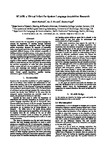KLAIR: a virtual infant for spoken language acquisition research
| dc.contributor.author | Huckvale, M | |
| dc.contributor.author | Howard, Ian | |
| dc.contributor.author | Fagel, S | |
| dc.date.accessioned | 2019-10-22T12:39:17Z | |
| dc.date.available | 2019-10-22T12:39:17Z | |
| dc.date.issued | 2009 | |
| dc.identifier.isbn | 978-1-61567-692-7 | |
| dc.identifier.issn | 1990-9772 | |
| dc.identifier.uri | http://hdl.handle.net/10026.1/15029 | |
| dc.description.abstract |
Recent research into the acquisition of spoken language has stressed the importance of learning through embodied linguistic interaction with caregivers rather than through passive observation. However the necessity of interaction makes experimental work into the simulation of infant speech acquisition difficult because of the technical complexity of building real-time embodied systems. In this paper we present KLAIR: a software toolkit for building simulations of spoken language acquisition through interactions with a virtual infant. The main part of KLAIR is a sensori-motor server that supplies a client machine learning application with a virtual infant on screen that can see, hear and speak. By encapsulating the real-time complexities of audio and video processing within a server that will run on a modern PC, we hope that KLAIR will encourage and facilitate more experimental research into spoken language acquisition through interaction. Copyright © 2009 ISCA. | |
| dc.format.extent | 696-+ | |
| dc.language.iso | en | |
| dc.publisher | ISCA | |
| dc.subject | speech acquisition | |
| dc.subject | machine learning | |
| dc.subject | autonomous agent | |
| dc.subject | situated learning | |
| dc.subject | toolkit | |
| dc.title | KLAIR: a virtual infant for spoken language acquisition research | |
| dc.type | conference | |
| dc.type | Conference Proceeding | |
| plymouth.author-url | https://www.webofscience.com/api/gateway?GWVersion=2&SrcApp=PARTNER_APP&SrcAuth=LinksAMR&KeyUT=WOS:000276842800172&DestLinkType=FullRecord&DestApp=ALL_WOS&UsrCustomerID=11bb513d99f797142bcfeffcc58ea008 | |
| plymouth.conference-name | Interspeech 2009 | |
| plymouth.publication-status | Published online | |
| plymouth.journal | Interspeech 2009 | |
| dc.identifier.doi | 10.21437/interspeech.2009-240 | |
| plymouth.organisational-group | /Plymouth | |
| plymouth.organisational-group | /Plymouth/Faculty of Science and Engineering | |
| plymouth.organisational-group | /Plymouth/Faculty of Science and Engineering/School of Engineering, Computing and Mathematics | |
| plymouth.organisational-group | /Plymouth/REF 2021 Researchers by UoA | |
| plymouth.organisational-group | /Plymouth/REF 2021 Researchers by UoA/UoA11 Computer Science and Informatics | |
| plymouth.organisational-group | /Plymouth/Users by role | |
| plymouth.organisational-group | /Plymouth/Users by role/Academics | |
| dc.identifier.eissn | 1990-9772 | |
| dc.rights.embargoperiod | Not known | |
| rioxxterms.versionofrecord | 10.21437/interspeech.2009-240 | |
| rioxxterms.licenseref.uri | http://www.rioxx.net/licenses/all-rights-reserved | |
| rioxxterms.type | Conference Paper/Proceeding/Abstract |


